Master Power Automate Desktop: Guide to Automation

What is Power Automate?
Power Automate is a versatile platform designed to help users enhance efficiency by automating workflows across different applications and services. With this service, individuals can design automated workflows, known as “flows,” which help minimize the time spent on repetitive activities.
Power Automate Desktop enhances these capabilities by enabling automation for local applications and data directly on users’ computers.
Desktop flows cater to a wide range of users who engage in both simple and complex tasks that follow specific rules on their machines. These flows expand the functionality of robotic process automation (RPA) within Power Automate, providing a powerful tool for automating any repetitive desktop activity.
Installation Steps for Power Automate Desktop
1) Download Power Automate Desktop:
- Visit the Power Automate Download Page.
- To begin, click the “Download” button to obtain the installer.
2) Install Power Automate Desktop:
- Run the downloaded installer.
- Follow the on-screen prompts to complete the installation. You may need to accept the license agreement and choose an installation folder.
3) Sign In:
- Once installed, open Power Automate Desktop.
- Sign in with your Microsoft account.
4) Explore the Interface:
Familiarize yourself with the user interface, including the action pane, workspace, and flow designer.
Key Features of Power Automate
- Automated Workflows: Create workflows that connect various applications and services, reducing manual effort and increasing overall efficiency. This is particularly valuable in environments where multiple applications are used.
- Triggers and Actions: Workflows begin with a trigger (e.g., receiving an email or a new file being created). They can then perform a series of actions, such as sending notifications, moving files, or updating databases, and automating complex processes.
- Pre-built Connectors: Power Automate includes a vast library of pre-built connectors that facilitate integration with popular services such as Microsoft 365, SharePoint, Salesforce, and Twitter. This integration facilitates smooth data exchange between various applications.
- Templates: The platform offers numerous ready-to-use templates for common automation scenarios. These templates allow users to get started quickly without needing to build flows from scratch, making automation accessible even for beginners.
- Mobile App: Users can manage and monitor their flows on the go using the Power Automate mobile app. This mobile capability enables quick actions and timely notifications, keeping users informed and engaged.
- AI Builder: With AI Builder, users can enhance their workflows with intelligence features, such as form processing and text recognition. This addition allows for more advanced automation scenarios, leveraging machine learning capabilities.
- Business Process Flows: This feature enables users to create guided processes that ensure consistency and compliance within organizations. It’s especially useful for teams that need to adhere to specific workflows or regulations.
Use Cases for Power Automate Desktop
- Data Entry Automation: Automate repetitive data entry tasks across multiple applications to reduce errors and save time.
- File Management: Automatically organize, rename, and move files based on predefined rules.
- Email Management: Set up workflows to automatically sort and categorize emails, respond to inquiries, or extract attachments.
- Report Generation: Generate reports by pulling data from various sources and consolidating it into a single document.
- Web Scraping: Extract information from websites and process it for analysis or record-keeping.
Benefits of Using Power Automate
- Increased Productivity: Automating routine tasks allows users to focus on more strategic work, enhancing overall productivity.
- Cost Savings: By reducing the time spent on manual tasks, organizations can achieve significant cost savings.
- Improved Accuracy: Automation minimizes human errors associated with repetitive tasks, leading to more reliable outcomes.
- Scalability: As organizations expand, Power Automate can adapt to accommodate the rising need for automation throughout different departments.
Now let’s see an example of a process flow for fetching weather data from OpenWeatherMap using Power Automate Desktop, including a detailed breakdown of each step:
Goal: Create a flow that retrieves current weather data for a specified city, stores it in a data table, and then exports the data to a CSV file.
Step-by-Step Process Flow
1. Initialize Variables:
a. Action: Set Variable
- APIKey: Store your OpenWeatherMap API key.
- City: Specify the city for which you want to fetch weather data (e.g., “London”).
- APIUrl: Construct the API URL using the city and API key.

2. Send HTTP Request
a. Action: Download from web
- Method: GET
- URL: Use the APIUrl
- Response Variable: Store the response in a variable called ApiResponse.
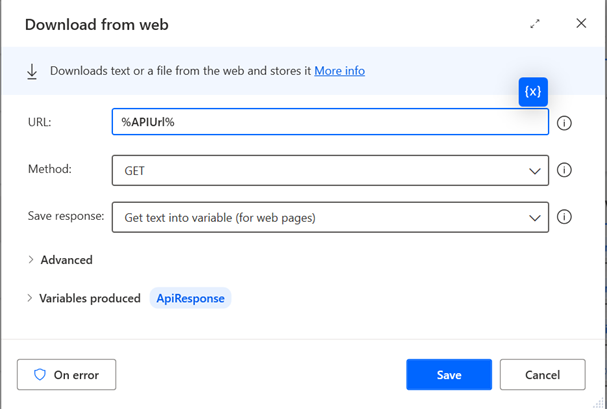
3. Parse JSON Response:
a. Action: Convert JSON to Custom Object
- Content: Use the ApiResponse variable.
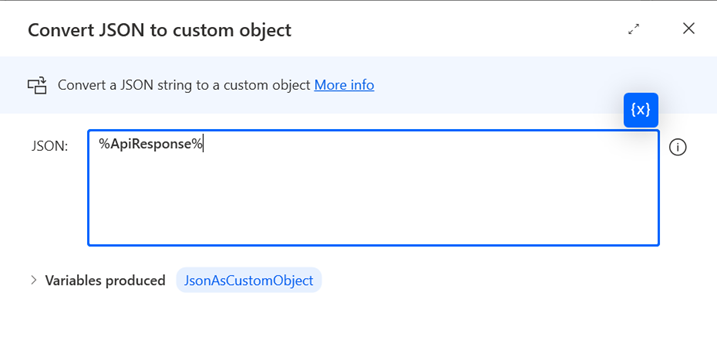
4. Create Data Table:
a. Action: Create New Data Table
- Columns: Define columns for your data table
- Example Columns: Temperature, Humidity, Description

5. Add Data to Table:
a. Action: Add Row
b. Data Table: Use the data table created in the previous step.
c. Values: Populate the row with values extracted from the parsed JSON:
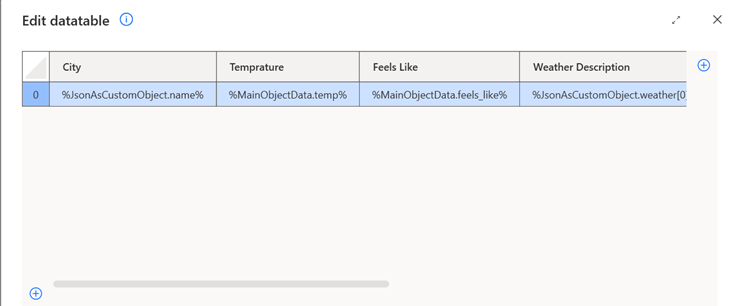
6. Write Data to CSV:
a. Action: Write to CSV
- Data Table: Use the data table containing the weather data.
- File Path: Specify the file path where the CSV will be saved (e.g., C:\WeatherData.csv).
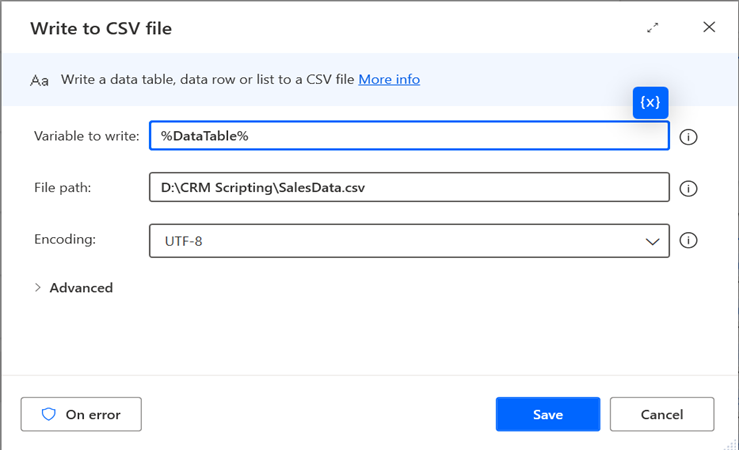
7. End of Flow: add a message or log indicating that the flow has been completed successfully.
8. Visual Representation of the Flow:
a. You can represent the flow visually in Power Automate Desktop with shapes and arrows indicating the sequence of actions. For example:
b. Start → Set Variables → HTTP Request → Parse JSON → Create Data Table → Add Row → Write to CSV → End
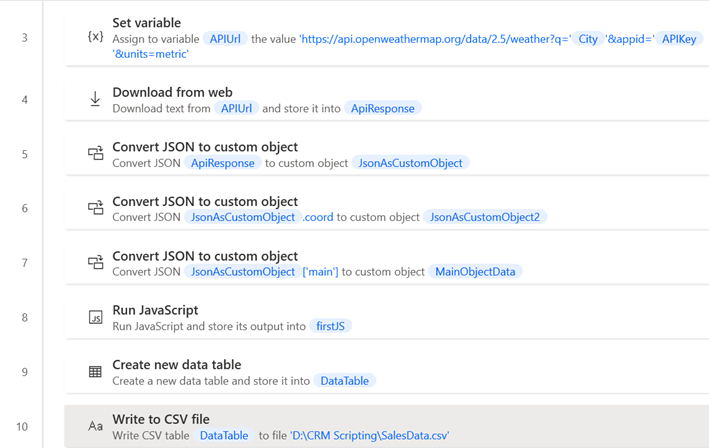
9. Output: Below is the output that we get in CSV file.

Challenges faced
JSON Data field issue
If the data we fetched from any API has the subparts in it, we cannot use that directly into the Data table. For using this data, we must use the Convert JSON to Custom object Action method.
a. Example- %JsonAsCustomObject.coord%
If the above version is also not working, then we must use the format below to insert the data into the Data table.
a. Example- %JsonAsCustomObject[‘main’]%
Conclusion
Power Automate Desktop empowers users to streamline workflows and automate repetitive tasks, enhancing productivity and efficiency. By leveraging its features, individuals and organizations can improve processes, reduce errors, and save valuable time.
Why Choose Blueflame Labs as Your Power Automate Desktop Partner:
Blueflame Labs can provide valuable services to help you harness the power of Power Automate Desktop. Here are some key benefits:
- Expert Guidance: Our team of experienced consultants can help you identify automation opportunities and design tailored solutions.
- Customized Solutions: We work closely with you to understand your specific requirements and develop workflows that meet your unique needs.
- End-to-End Support: From initial setup to ongoing maintenance, we provide comprehensive support throughout the automation process.
- Proven Success: We have a track record of delivering successful Power Automate Desktop implementations for clients across various industries.
- Cost-Effective Solutions: Our services are competitively priced, ensuring you get maximum value for your investment.
Contact us today to discuss your specific needs and learn how Blueflame Labs can help you automate your workflows and drive business growth.


